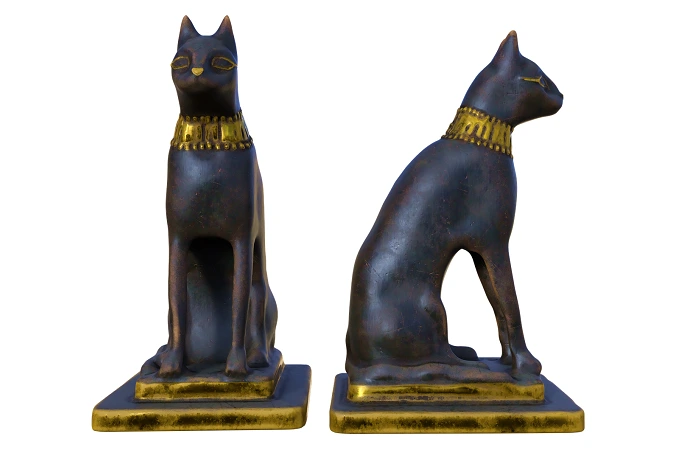The ancient Egyptian gods and goddesses usually wore bird and cat or lion masks. Most of the masks carried the meaning of creation, destruction, and rebirth.
Cats were particularly beloved by the ancient Egyptians, as is widely documented. The sleek cat, revered for its hunting talents, was elevated to the level of a demigod in ancient Egypt, where it became a vital component of the community.
The Egyptians had a deep affection for lovely purrs, as seen by the lavish paintings on their tombs, the towering sculptures, and the exquisite decorations that adorned them. When it came to cats in the land of the pharaohs, they were nurtured, revered, and safeguarded.
The killing of cats for ceremonial purposes was allowed; however, the unlawful slaughter was severely punished, with the culprit being condemned to death. Cats had a prestigious standing in ancient Egypt for ages, as shown by the extensive documentation found in ancient sources. It was only with the arrival of Christianity that humming began to lose its popularity.
The Egyptian cat goddesses
1. Goddess Bastet
Bastet goddess with a cat’s head. This Egyptian goddess was the patroness of cats, women and children. Her importance has changed over the years. She is also known as the goddess of love, fertility, birth, music and dance. Cats were sacred to Bastet as a symbol of animal passion.
Basta’s devotees honored their mistress with processions from flower boats and orgiastic ceremonies. Her festivals were licentious and quite popular. She was considered the protector of the pharaoh and thus the later chief male deity, Ra, who was also a sun deity, giving her the titles Lady of the Flame and Eye of Ra.
2. Goddess Mafdet
She is probably one of the earliest feline deities and was either a cheetah, a lynx, or a leopard. She was described with braided hair that was said to represent the joined bodies of the scorpions she had killed. Her name is said to mean “runner”, suggesting an association with the cheetah, the fastest of the felines.
Mafdet was the god of execution. She was also associated with the protection of royal chambers and other sacred places, as well as protection from poisonous animals. Because venomous animals such as scorpions and snakes are killed by felines, Mafdet was viewed as a feline goddess. She was given the title “snake killer”. Her cult was eventually replaced by that of the goddess Bastet.
3. Goddess Mut
A widely revered mother goddess, Mut is another deity who can be fully human or lion-headed. She was the wife of Amon-Ra and the mother of the moon god Khonsu. In addition to the cat and the lion, her other sacred animal was the vulture.
4. Goddess Pakhet
The lion-headed goddess, Pakhet is virtually unknown in comparison to Bast and Sekhmet. Pakhet was worshiped in Middle Egypt, and she had a temple that was carved into the solid rock near the modern village of Beni Hasan in the eastern desert. Like Sekhmet, she was considered a fierce Goddess, her name means “tearing”.
5. Goddess Sekhmet
In Egyptian mythology, Sekhmet is one of the Egyptian goddesses of cats and was originally a warrior goddess of Upper Egypt. She is depicted as a lioness, the most ferocious huntress known to the Egyptians. It was said that her breath created the desert. She was considered the patroness of the pharaohs and led them to war. Her name corresponds to her function and means powerful. She was also given the titles of Whom Evil Trembles, Mistress of Fear and Mistress of Murder.
Sekhmet was believed to protect the pharaoh in battle, roam the earth and destroy the pharaoh’s enemies with fiery arrows. The ancient Egyptian sun deity, her body received the bright light of the midday sun, giving her the title Lady of the Flame. Death and destruction are the balms for her warrior’s heart, and the hot desert winds are her breath.
To appease Sekhmet’s wrath, her priestesses performed a ritual every day in front of different statues of the goddess. This practice has resulted in many depictions of the goddess being preserved. More than seven hundred statues of Sekhmet are thought to have once stood in just one mortuary temple of Amenhotep III on the west bank of the Nile.
6. Goddess Tefnut
She was the lunar goddess of moisture, humidity and water, who was also the sun goddess associated with the sun and dryness (more precisely, the lack of moisture). Tefnut was usually depicted as a woman with the head of a lion or as a full-fledged lioness. Sometimes she was in the form of a woman, but this is very rare. She was often depicted with a scepter and the sign of life ankh.
It was believed that Tefnut was a frustrated goddess who fled to Nubia, taking all her water and moisture with her. Egypt soon dried up, and chaos reigned in the country, while she was in Nubia, Tefnut turned into a lioness and continued to kill in anger.
In the end, Ra decided that he missed her and wanted her back. Ra sent Thoth and Shu after her, and they found her in Begum. He immediately began to persuade her to return to Egypt. Eventually, Tefnut (led by Shu and Thoth) returned in triumph to Egypt, accompanied by many Nubian musicians, dancers and baboons.
She went from city to city, bringing moisture and water, bringing great joy, until at last, she was reunited with her father and restored her rightful position in his eyes. This story also explains how the goddess of moisture could also be the goddess of dryness, heat, and the negative aspects of the sun.
